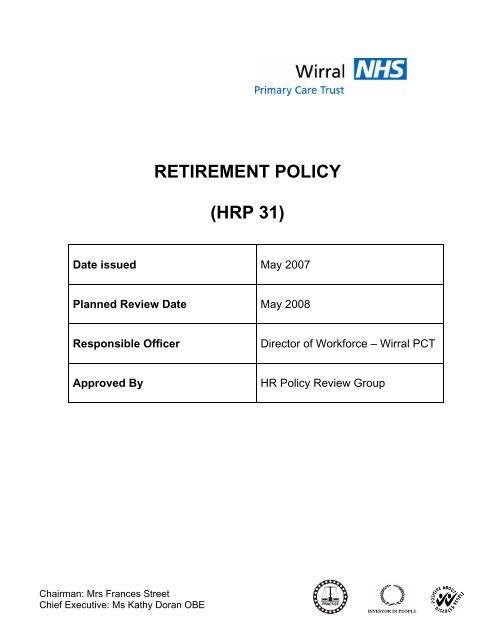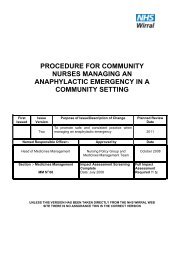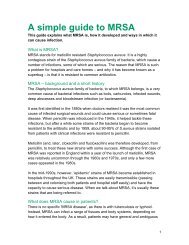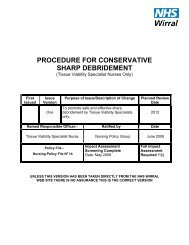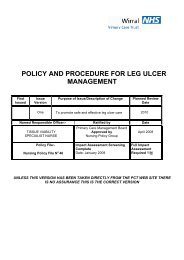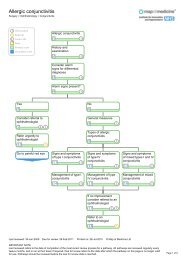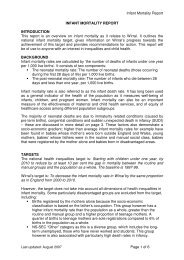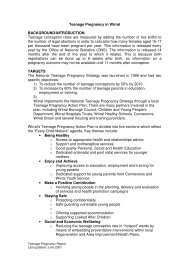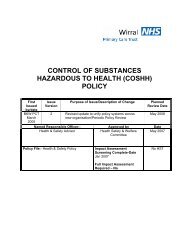RETIREMENT POLICY (HRP 31)
RETIREMENT POLICY (HRP 31)
RETIREMENT POLICY (HRP 31)
You also want an ePaper? Increase the reach of your titles
YUMPU automatically turns print PDFs into web optimized ePapers that Google loves.
<strong>RETIREMENT</strong> <strong>POLICY</strong>(<strong>HRP</strong> <strong>31</strong>)Date issued May 2007Planned Review Date May 2008Responsible OfficerDirector of Workforce – Wirral PCTApproved ByHR Policy Review GroupChairman: Mrs Frances StreetChief Executive: Ms Kathy Doran OBE
CONTENTS1.0 INTRODUCTION1.1 Rationale1.2 Scope1.3 Aims2.0 <strong>RETIREMENT</strong> PRINCIPLES2.1 Retirement Options2.2 The Employment (Age) Regulations 20063.0 PROCEDURE3.1 Formal Pre-Retirement Procedure for staff nearing default retirementage of 654.0 IMPLEMENTATION AND COMPLIANCE4.1 Implementation4.2 Compliance5.0 TRAINING AND IMPLEMENTATION6.0 DISTRIBUTION7.0 MONITORING AND REVIEW8.0 REFERENCE DOCUMENTSWorkforce Retirement Policy (<strong>HRP</strong><strong>31</strong>) 2
INTRODUCTION1.1 RationaleWirral Primary Care Trust recognises that its success depends on its ability toattract, recruit and retain suitably qualified, skilled and experienced staff,particularly as the demand for healthcare grows. The Trust also recognises theimportance of supporting its staff to achieve a balance between their work andhome life not just during employment but also in planning the transition toretirement at a time and pace which suits the individual.1.2 ScopeThe policy applies to all directly employed PCT staff irrespective of contractedhours, grade, status or gender.1.3 AimsThe aims of the policy are:i. To allow sufficient flexibility in terms of the options for retirement toaccommodate the needs of the service and those of the individual.ii. Increase age diversity in the workforce.iii. To retain skilled and able workers.iv. To aid in workforce planning.v. To provide guidance so that managers and staff are aware of the options thatare available and the ability of the individual to make choices about the way inwhich they wish to retire and their eventual retirement.vi. To clarify the rights of the individual and the organisation.Vii To meet the extended working requirements of the Employment Equality(Age) Regulations 2006.vii. Increase employee commitment and loyalty through enabling more ownershipof length of working lives.2.0 <strong>RETIREMENT</strong> PRINCIPLES2.1 Retirement Optionsi. At present, entitlement to State Retirement Pension begins at 65 years formen and 60 years for women where an insurance contribution has beenpaid.ii.From 6 April 2020, however, state pension age for both men and womenwill be 65. The Government will introduce the change gradually from age60 to 65 for women over a 10-year period from 2010 to 2020. (A Guide toWorkforce Retirement Policy (<strong>HRP</strong><strong>31</strong>) 3
the change in the state pension age for women can be obtained from theDepartment for Work and Pensions - telephone 0845 7<strong>31</strong>3233 or visit theirwebsite at www.pensionguide.gov.uk).iii.ivEmployees who are members of the NHS Pensions Scheme will receiveretirement benefits, which consist of an annual pension paid for life and atax-free lump sum. The amount received depends on the individuals’pensionable pay, how long they have been a member of the scheme andwhether they have worked part-time.Employees who have contributed to the NHS Pension Scheme will qualifyfor retirement benefits from the pension scheme at age 60. (NB correct atthe time of writing, however, the pension scheme is currently underreview).v. An employee who is aged 50 or over may choose to take early retirementunder the NHS Pension Scheme’s Voluntary Early Retirement Scheme.Their benefits will, in most cases, however, be reduced to cover the extracost of receiving a pension for a longer period.vi.vii.viii.ix.There are people in certain staff groups with Special Class Status, whowere members of the NHS Pension Scheme before 6 March 1995 andwho have qualifying service. They can retire with full pension benefitsfrom age 55 although the same conditions with regard to retirement beforeage 55 still apply. Special Class Status is no longer granted to newentrants to the Scheme on or after 6 March 1995. Re-entrants to SpecialClass type employment retain the status in the Scheme if they do not havea break in pensionable scheme membership of 5 years or more.Where employees opt to take early retirement they can return to work forthe NHS if they wish to do so, but there are limits on the number of hoursthey may work (see also 2.1.x). Should an employee be consideringtaking early retirement, they are advised to seek advice from the PensionsOfficer (see paragraph 2.1.xiii for contact details).Other retirement options include situations where employee makes aspecific request, e.g., ‘winding down’ working fewer days in the currentpost or alternatively move to another part-time post at the same grade.Employees who defer retirement in this way (and continue theirmembership of the scheme) will carry on building up pension entitlements.Another option is for employees to defer retirement and ‘step down’ to aless demanding, lower graded (paid) post. Subject to the Trust’sagreement, pension rights may be preserved at the previous higher level.x. Before age 60, employees can also retire, receive a pension and resumeWorkforce Retirement Policy (<strong>HRP</strong><strong>31</strong>) 4
working for the Trust. Because they have retired they will no longer be amember of the pension scheme and will not build up any further pensionentitlements. Providing an employee is over 60, the amount they earn hasno effect on their pension. However, if under 60, an employee cannotearn more through pension and post-retirement employment than theirsalary at retirement. Where this happens their pension will be reduced.Pensioners cannot work more than 16 hours a week within the firstcalendar month of retirement otherwise their pension will be suspended.xi.xii.xiii.In the case of 2.1.x above, the Trust will consider any request from anindividual who is seeking to resume work and will do so consideringindividual, team, departmental, service and organisational need, however,the Trust can refuse the request and is not required to provide a reasonshould such requests be declined. This does not prevent the employeefrom applying for a post within the Trust in accordance with the normalrecruitment and selection procedure.Alternatively, individuals who are interested in returning to work but whodo not want to commit themselves to regular hours may wish to explorebank working admin arrangements.Employees who are interested in pursuing any of the above optionsshould seek advice in the first instance from their line manager, theWorkforce Department on 0151 643 5369, Ann Molyneux, the PensionsOfficer on 0151 334 4000 or the NHS Pensions Helpline on 01253774440. The retirement package selected may affect an individual’spension and anyone coming up to retirement is advised to check theirterms and conditions before finalising their arrangement2.2 The Employment (Age) Regulations 2006i. The above regulations allow the Trust to retire employees at age 65 whichthe Trust has set as the default retirement age in accordance with theregulations.ii.iii.The regulations also allow employees the right to request to continueworking beyond the retirement age of 65 and outline the procedure whichmust be followed to allow a ‘fair retirement’.The Trust has an obligation to consider such requests and will do so inconjunction with individual, team, department, service and organisationalneed. The Trust can refuse the request and is not required to give areason for this decision, however, wherever possible a full explanation willbe provided to the employee.Workforce Retirement Policy (<strong>HRP</strong><strong>31</strong>) 5
3.0 PROCEDURE3.1 Formal Pre-Retirement Procedure for staff nearing default retirementage of 65i. NotificationThe Workforce Department will write to employees (copied to lineManager) giving notice of their default retirement date (65) not more thanone year but not less than six months before the default retirement dateoutlining the employee’s right to request to work beyond the retirementage.ii.Application for extended workingIf an employee wishes to request extended working past the defaultretirement date they must put the request in writing at least three monthsbefore the default retirement date stating whether they wish to continuework indefinitely, for a stated period or until a certain date.iii.Meeting to DiscussIf an application for extended working is received a formal meeting mustbe convened within 15 working days following receipt of the request withthe line manager and a Workforce Manager to discuss and consider therequest. The employee is entitled to be accompanied at this meeting by atrade union representative or workplace colleague of their choice. Theline manager and employee may explore alternatives to current post asappropriate, i.e. reduced hours/wind-down/step-down.A decision must be made on whether to accept or decline the request andconfirmed in writing to the employee within 10 working days of the date ofthe meeting. Requests should be considered objectively in conjunctionwith a Workforce Manager; applications may be refused where there is aclear business reason, although it has to be acknowledged that it will bedifficult to identify one.If a request for extended working is approved a new retirement dateshould be agreed for 12 months later(N.B this then becomes the defaultretirement date and this process will need to be repeated on an annualbasis).iv.AppealIf the application is refused employees have the right to appeal againstthis decision to the Director of Workforce within 21 working days of theWorkforce Retirement Policy (<strong>HRP</strong><strong>31</strong>) 6
date of the rejection in writing detailing the grounds of the appeal. Theappeal should be addressed to the Director of Workforce and copied tothe Head of Service.The appeal process will then follow the standard Grievance Policy (<strong>HRP</strong> 2).4.0 IMPLEMENTATION AND COMPLIANCE4.1 Implementationi. This Policy has been jointly agreed within the HR Policy Review Groupwhich is a sub group of the Joint Forum.4.2 Compliancei. The Trust Board has a strategic responsibility to ensure that the policy iscommunicated to all staff and is effectively implemented.ii.The Director/Deputy Director of Workforce will:-a) oversee the introduction, operation and monitoring of the policy;b) ensure the provision of guidance and support for Managers on theoperation of the Policy.iii.The Workforce Managers will:-a) provide advice and guidance to managers on the policy and itsapplication;b) assist and provide appropriate support and information to employeeswith regard to this policy.i. Heads of Service will:-a) apply the principles of the policy fairly and sensitively;b) ensure that all staff are aware of and understand the policy.ii. Trade Union Representatives will:-a) support the fair and equitable application of this policy;b) provide advice and support to employees.iii. Employee Responsibilities:-a) all employees will observe the principles of the policy and whereappropriate follow the stated application processes.Workforce Retirement Policy (<strong>HRP</strong><strong>31</strong>) 7
5.0 TRAINING AND COMMUNICATION5.1 The Workforce Directorate will ensure that appropriate briefings, guidanceand support is available to management on the operation of this policy.6.0 DISTRIBUTION6.1 This policy will be available to all HR Policy Manual Holders. Copies willalso be available from the Workforce Department and also on the Trust’swebsite.7.0 MONITORING AND REVIEW7.1 This policy will be reviewed on a regular basis and will be reviewed a yearafter its implementation.8.0 REFERENCE DOCUMENTSAge and the workplace – a guide for employers – ACASWorkforce Retirement Policy (<strong>HRP</strong><strong>31</strong>) 8
SAMPLE LETTER ADIVISING EMPLOYEE OF INTENDED DATE OF<strong>RETIREMENT</strong>DearIn accordance with the Trust Retirement Policy (copy attached), I write to confirmthat you will be retired from your employment with the Trust with effect from[insert retirement date].You have the right to request to continue to work beyond this date and thereforenot to retire. This request should be in writing to {insert name of line manager]and should make clear that it is a request not to retire and must propose whetheryou wish your employment to continue, for a stated period or until a specifieddate. This request must be received no later than three months before the dateof retirement. Failure to submit such a request within this timeframe will result inthe loss of your statutory right to have your request considered and you will beretired on the retirement date above.Please refer to the Trust Retirement Policy for further information on the preretirementprocess. Alternatively, please do not hesitate to discuss this with yourline manager or designated Workforce Manager.Yours sincerelyNameJob TitleWorkforce Retirement Policy (<strong>HRP</strong><strong>31</strong>) 9
SAMPLE LETTER ADVISING EMPLOYEE OF DATE OF MEETING TODISCUSS REQUEST TO CONTINUE WORKING BEYOND DEFAULT<strong>RETIREMENT</strong> AGE OF 65DearI write further to your request dated [insert date] to continue to work beyond thedefault retirement age of 65.I have arranged a meeting which will be held onatinto discuss and consider this request further. I have madearrangements for [name], [job title – Workforce Manager] to be present for adviceand you have the right to be represented by a companion (e.g. a trade unionrepresentative or work colleague) should you so wish. It is your ownresponsibility to make the necessary arrangements.I would be grateful if you would confirm your attendance at the meeting bycontacting [insert name, department and contact telephone number).Yours sincerelyNameJob TitleWorkforce Retirement Policy (<strong>HRP</strong><strong>31</strong>) 10
SAMPLE LETTER ADVISING EMPLOYEE OF OUTCOME OF MEETING TODISCUSS REQUEST TO CONTINUE WORKING BEYOND <strong>RETIREMENT</strong> AGEOF 65 AND RIGHT OF APPEAL WHERE REQUEST HAS BEEN DECLINEDDearI write further to our meeting held on [insert date] in the presence of [insertnames of those present]. The purpose of the meeting was to discuss yourrequest to continue working beyond the default retirement age of 65.After due consideration, I write to advise thata) your request has been declined and the Trust will retire you from youremployment on [insert date].The reason for my decision is thatYou have the right to appeal against this decision. If you wish to do so, thisshould be in writing, stating the grounds for the appeal to the Director ofWorkforce, within 15 days of the date of this letter confirming my decision.ORb) your employment with the Trust will continue beyond the defaultretirement age of 65• Annual reviews(NB – it may also be necessary to outline any variations which were agreed i.e.on reduced hours etc).Please be advised that your revised date of retirement will be [insert date].Yours sincerelyNameJob TitleWorkforce Retirement Policy (<strong>HRP</strong><strong>31</strong>) 11


